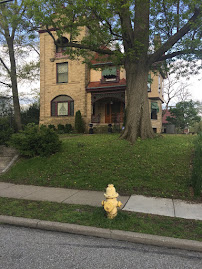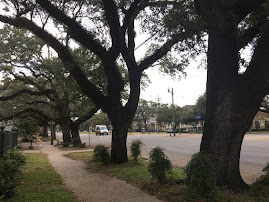
New houses in the Lower Ninth Ward
Dear George,
Hurricane Katrina struck S.E. Louisiana on the morning of Monday, Aug. 29, 2005. With winds up to 145 m.p.h., it was the most powerful hurricane ever recorded in the Gulf of Mexico. The Gulf coast was torn apart, much of the destruction due to a 29-foot storm surge. We breathed a great sigh of relief when TV news indicated that the storm had veered slightly away from New Orleans proper. However, that was short-lived -- the city’s federally built system of levees and floodwalls failed hours after the storm had moved inland. Our son J and daughter-in-law K’s new Midtown house was right at the center of the incoming waters and would wind up needing to be completely gutted. Soon 80% of the city was under water, with water depths reaching as high as fifteen feet. Mayor Ray Nagin had ordered the city’s first evacuation in history, and approximately 80% of New Orleans’ residents had left. About 10,000 people, mostly poor, African-American, and elderly, took refuge at the Louisiana Superdome near downtown. Our daughter-in-law K remained on duty at Charity Hospital where the staff struggled to maintain subsistence services in the absence of electricity and sufficient food and water for nearly a week. Over 1500 people died in Louisiana from the hurricane and its effects. The total property damage from Hurricane Katrina was estimated at $81 billion. Over 200,000 homes in New Orleans were destroyed or severely damaged, and over 800,000 citizens in the metro area were displaced. Michael Chertoff, Homeland Security Secretary, described Katrina and its aftermath as “probably the worst catastrophe” in U.S. history. Katja and I flew into New Orleans to visit J and K about six months after the storm. We arrived at night, and, looking down from the plane windows, vast portions of the metro area were totally dark, attesting to the destruction of much of the city. While the French Quarter and the Garden District, on higher ground, remained relatively intact, many of the neighborhoods J took us through were demolished, and the Lower Ninth Ward looked like an atomic bomb had struck. In January 2006 the city’s population was down to 200,000, less than half of what it had been before Katrina.
We’ve tried to keep track of the city’s recovery efforts in the six years since, and the reports have been mixed, both heartening and frustrating. Though there has been severe criticism of federal, state, and local responses, recovery efforts began soon after the catastrophe. Crews began restoring power to the central business district by Monday, Sept. 5, and the Port of New Orleans began receiving commercial shipments by late September. 18,000 members of the American Library Association held their annual convention in New Orleans in June 2006, and other large conventions soon followed. A big boost to community morale occurred when the New Orleans Saints held their NFL home opener at the Superdome on Sept. 25, 2006. Mardi Gras, of course, was never called off.
People’s return to the city has been steady over the past six years, though it has not proceeded as rapidly or fully as some had predicted. By July 2007 the city’s population approached 300,000, down from about 455,000 before Katrina. In April 2010 city residents had reached slightly over 356,000, about 29% below the pre-Katrina level. Compared to the 2000 census, by 2010 the city had lost over 118,500 African Americans and 24,000 whites, while gaining 3,225 Hispanics. Overall, the African American population dropped from 67 to 60%; whites grew from 28 to 33%, and Hispanics increased slightly from 3% to 5.2%. Some of the displaced people had moved to nearby parishes (e.g., St. Tammany’s), several of which have actually seen a population growth, but, overall, the metropolitan area has still suffered a loss of 150,000 people.
Reconstruction has proceeded most fully in areas of the city least damaged by the storm. These are areas built on higher ground and developed before 1900, e.g., the French Quarter, Old Marigny, Uptown, the Old Warehouse District, as well as areas built along natural ridges, e.g., Esplanade Ridge, Bayou St. John. A 2008 survey found that 62% of homes in flooded areas of New Orleans had been rebuilt or were under renovation, a substantial increase from figures of 15% and 35% in 2006 and 2007 surveys. According to a 2011 report, about 25% of the city's housing stock is currently vacant and abandoned, roughly the double the number from a decade ago. Whereas vacant homes used to be concentrated in older neighborhoods west of the Industrial Canal, now they're spread across the city and suburbs. The loss of population makes further progress difficult. The Lower 9th Ward, one of the most heavily damaged sections of the city, has been one of the slowest to recover.
After six years of intensive work and $8 billion spent, the Army Corps of Engineers has largely met its 2011 deadline to provide a standard of 100-year hurricane protection for New Orleans. The hurricane protection system is designed to meet three goals: (a) block storm surge from canals into residential and commercial areas; (b) make existing levees and floodwalls resilient enough to withstand overtopping; (and (c) to storm-proof pump stations. John Barry, V.P of the S.E. Louisiana Flood Protection Authority-East, has stated, "I think the protection system does look like it will do what it's designed to do, and the city is therefore safer than it's been in decades." At the same time he notes that "100-year protection is an extraordinarily low standard," and despite this major progress, failure of the levee-system from a Katrina-level hurricane is still a possibility. Barry comments, "I think what it indicates, really, is the need for us to do a lot more."
The federal government has provided around $33 billion in recovery money, and, though much of it is still unspent, the funding has helped to support the region’s economy during the nation’s recession. Thus, while median household incomes fell 7 percent in the country at large over the last decade, household income gained nearly 2% in New Orleans. The rate of individuals starting up new business was about 28% higher in metro New Orleans than in the country at large. Sales tax collections are nearly as high in 2011 as they were in 2005 before Katrina, despite a loss of over a quarter of the population. Unemployment in the U.S. increased from 5.0% to 9.1% from 2005 to 2011, but only from 5.3% to 7.8% in New Orleans. The official report of the sixth anniversary of Katrina notes a reawakening of civic leadership, adoption of a city-wide master plan, implementation of some political reforms, less waste in public spending, and new investments in health care, public education, and public housing. Construction will begin this year on a $995 million replacement for the Veterans Administration Medical Center (where K works), followed by a $1.2 billion University Medical Center next door which will replace Charity Hospital. 68% of children in New Orleans now attend academically satisfactory schools in 2010, up from 28% before the hurricane. Before Katrina less than a quarter of children scored at or above the “basic” level on state tests; now nearly half do.
New Orleans was a poor city before the storm, and conditions today are worse for minorities and the poor than before Katrina. More white residents returned to their home than did black residents. This has been attributed to the unwillingness of planners to rebuild low-income housing. Most low-cost housing in New Orleans was wiped out and not replaced. A long-time Louisiana congressman reportedly told lobbyists, “We finally cleaned up public housing in New Orleans. We couldn’t do it, but God did.” Income inequality, already very high, has increased slightly since Hurricane Katrina, with African-American households earning 50% less than whites; Hispanic households, 30% less. Affordable housing is scarce. Before Katrina about 40% of renters were paying over a third of their pre-tax income for rent and utility; now that figure is up to 55%. Because of the inability of many impoverished former residents to return, the percent of New Orleans adults with a bachelor’s degree or higher increased from 26% to 33% from 2000 to 2010, while adults without a high school degree dropped from 25% to 16%, The poverty rate declined from 27% in 1999 to 21% in 2007, though, because of the recession, it returned to 27% by 2010. Suburban poor now outnumber those in New Orleans. Homicide rates were exceedingly high before Katrina, and, while they dipped during the year following Katrina, they remain about ten times higher than the national average today.
Citing the city’s redesign of its health care and criminal justice systems, Mayor Mitch Landrieu recently stated that “our story is one of redemption and resurrection. We are…creating the city we want to become, brick by brick and block by block.” On the six-year anniversary of Katrina, the editorial staff of the Times-Picayune offered its assessment that "metro New Orleans is deep into its recovery from the catastrophe." The editorial writers noted the massive effort to repair public infrastructure that's in progress, the reduced risk of flooding from future storms, and a revolution in New Orleans' public schools. At the same time, they called for federal priorities to address unfulfilled commitments for coastal restoration and to upgrade a flood protection system to protect the region from the strongest storms. The Louisiana wetlands serve as the city’s buffer from storm surges, but they have been substantially depleted over the last century, and meaningful effort to restore the wetlands has yet to begin. President Obama included $35 million for coastal restoration in his budget proposal, but Congress eliminated all but a million dollars of that money. The Times-Picayune concluded, "we need the president and the Congress to understand that our region's long-term safety is just as important as helping us recover from Katrina." We’re scheduled to visit J, K, and our grandkids in a month or two. We’re thrilled to be getting together with our family again and eager to see firsthand how the city’s doing too.
Love,
Dave
Sources:
www.brookings.edu (“The New Orleans Index,” 8-29-11)
www.gnocdc.org (“What Census 2010 reveals about population and housing in New Orleans and the Metro area,” 4-15-11; “Who lives in New Orleans and the Metro area now?”, 9-26-11)
www.kaiserpolls.org (“New Orleans five years after the storm,” Aug. 2010)
www.myneworleans.com (“2,000 days later: How are we doing?,” April 2011)
www.nola.com (“6 years later, Hurricane Katrina’s scars linger alongside robust recovery,” 8-28-11; “Completion of New Orleans’ "The agenda100-year flood protection system is a significant recovery milestone: An editorial”, 5-29-11; “New Orleans’ official 2010 census population is 343,829, agency reports,” 2-3-11; “The agenda pending for our recovery from Hurricane Katrina: An editorial," 8-28-11; "Residents, officials gather in Lower 9th Ward on 6th anniversary of Hurrican Katrina," 8-29-11)
www.nolaoig.org (“Crime in New Orleans: Analyzing crime trends and New Orleans’ responses to crime,” 8-15-11)
www.nytimes.com (“Hurricane Katrina”, updated 8-25-10; “Lessons from New Orleans,” 10-15-11; “The State of New Orleans,” 8-28-10)
www.wikipedia.org (“Hurricane Katrina”; “Effects of Hurricane Katrina in New Orleans”; “Reconstruction of New Orleans”)
G-mail Comments
-Phyllis S-S (10-24): Dave, How interesting. What a lot of research you did. Phyllis
































































































































































